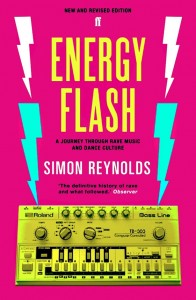Detroit techno, Chicago house, micro house, grime, 2step, gabba, speed garage, bro-step, drum and bass, happy hard-core, idm, edm, Miami bass, illbient, jungle, footsteps, trance, acid, acid house, progressive house, jerk, glitch, bassline, ghettotech, funky, trance, nu-breaks, big beat. Have I left anything out? That depends. What time is it?
Electronic music doesn’ make it easy for you. In the time it takes to come to grips with one new genre, you turn around and another seven have sprung up. Tangerine Dream fans can help explain this. Each new successive, increasingly complex album from their heroes charted the development of the sequencer. Yet they can’ explain it all, the rapid development of technology, and its decreasing cost, putting it in the hands of everyman is only part of the story.
UK music critic and author Simon Reynolds (Rip It Up and Start Again/ Retromania) not only manages to chart a remarkably coherent course through these multiple and diverse genres, but he draws out the links, the evolution, the crossover, the reactivity, analysing the characteristics of the music and demonstrating that speed garage may not be as far from Chicago house as you may initially think.
This music exists on a continuum, it may be non linear, and relationships may not immediately be apparent, but the melting pot of technology (or lack of it), social issues and drugs if working together have the ability to create something new, around which a scene develops. And charting these scenes is Reynolds forte. Writing from personal experience, attending the raves, interviewing the artists, label owners and organisers, he takes on the role of an ethnomusicologist, a raveologist if you will, charting the peculiar social mores of its participants, picking apart the sounds and finding meaning within the debauchery and madness.
From Tricky to Diplo, Sven Vath to Skrillex, Derrick May to Aphex Twin, Goldie to Paul Oakenfold, they’re all here, some of the personalities who either took rave music into strange idiosyncratic new directions, or rode the wave as far as it would go. The book is even named after an anthemic techno belter from Joey Beltram. It’s a personal account but Energy Flash is so comprehensively researched, so authoritative, so damn heavy, literally weighing in at over a kilo – and that’s in paperback. It’s either a door stopper or the techno bible.
He spends a lot of time on drugs, charting their effects, linking them to genres, and drawing parallels with changes in the music. It’s particularly insightful when detailing how the copious canning of ecstasy resulted in the drug losing its loved up buzz, so in an attempt to recapture that initial glow, participants would drop 7 or 8 in a night, and then the paranoia kicked in. Here he draws explicit parallels to the music turning darker, often speeding up and becoming more abrasive as participants chased the buzz with polydrug use.
He charts the rise of illegal raves as someone who was there, in both the UK and later in the US. He touches on the mainstreaming of rave culture, of football hooligans discovering ecstasy and house music as chronicled by Irvine Welsh, and organized crime cutting in on the action once serious money was to be made. He charts the media controversy about drug deaths across multiple scenes over the years, and the resulting public hysteria which inevitably resulted in draconian government crackdowns.
Originally published in 1998, Reynolds has twice updated this book: in 2008 and again 2013. The recent updates have added five new chapters, and it’s fascinating, charting the rise of dubstep and EDM, and in a sense crystallising what he’d been writing about all along, possibly without actually realising: the gradual mainstreaming of electronic music.
From a niche in the early nineties to the majority of the top 40 hits in 2013 now being electronic based, rave culture and dance music has left an indelible imprint on commercial music and popular culture.
What’s most apparent in his new chapters is how the internet has destroyed the purity of the development of electronic music, in this post everything world suddenly everything is up for grabs, from obscure Italian disco to Peruvian avant garde it’s all online waiting to be pilfered. The narrative has gone, the social and political circumstances almost irrelevant, and as a result everything has fragmented. Artists are recreating sounds from scenes they were never a part of without building upon them and listeners are welcoming the nostalgia. Then there’ the exotic electronics or ghettotech, bizarre bastardised party hard amalgams of traditional music and western styles like hip hop, house and techno, genres like, kwaito, cumbia, kuduro, reggaetron.
Where does it end? Well that’s what Reynolds’ is getting, it doesn’ and it shouldn’. Both subsumed by the mainstream and cast aside, there are peaks and troughs. Sure everything seems fragmented and incomprehensible now, but in three or four years Reynolds will come out with another chapter, or perhaps even a volume, and explain it to us. In the meantime if you want to make sense of our collective electronic past, and in doing so begin to understand the present there’ no better place than Energy Flash. Just don’ drop it on your foot.




